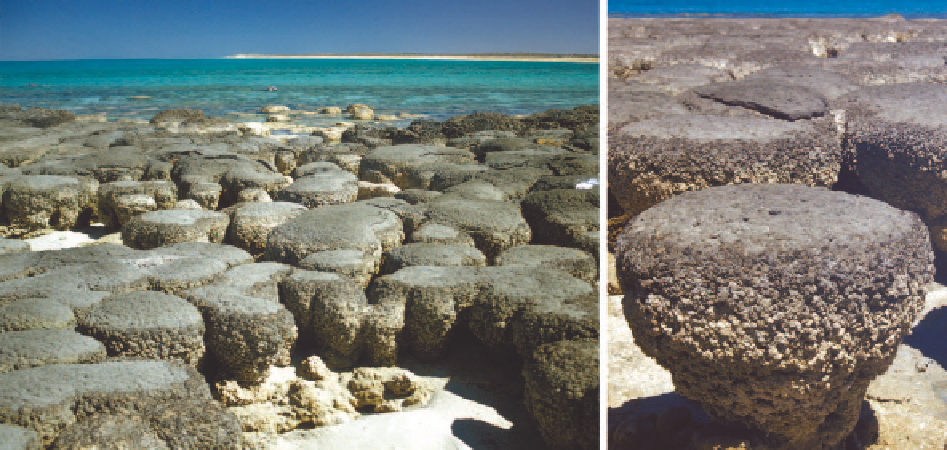Geology Reference
In-Depth Information
Fig. 9.2.
Holocene stromatolites
formed in an intertidal environment characterized by extreme salinity and limited water
circulation. Stromatolites grow slowly, less than 1 mm and as little as 0.04 mm/year. Hamelin Pool, Shark Bay, Western
Australia. Courtesy of R. Höfling, Erlangen.
Stromatolites are not necessarily carbonate, but may
be siliceous (Walter et al. 1972), evaporitic (Friedman
and Krumbein 1985; Gerdes et al. 1985; Renaut 1993;
Gasiewicz and Peryt 1994; Rouchy and Monty 2000),
or phosphatic (Krajewski et al. 2000). Widespread silici-
clastic stromatolites occur on modern temperate tidal
flats (Cameron et al. 1985; Gerdes and Krumbein 1986;
Noffke 1998). Carbonate-siliciclastic stromatolites are
common (Martin et al. 1993; Bertrand-Sarfati 1994).
The laminated fabric of stromatolites is distinct,
crude or diffuse (Pl. 8/2, Pl. 50/2), depending on the
degree of continuous development of the fabric. Stro-
matolite formation is favored by a regular and even
supply of sorted sediment over time and space onto
surfaces colonized by an even layer of microbes.
(2)
Skeletal stromatolites,
are produced by biochemi-
cal calcification of in-place organisms (cyanobacteria
and algae) and characterized by the presence of tubular
microfossils. This type seems to be restricted to ma-
rine and marginal-marine Paleozoic and Mesozoic car-
bonates. Some recent lacustrine stromatolites resemble
skeletal stromatolites but mineralization is more im-
portant than biomineralization in these freshwater mi-
crobial carbonates.
(3)
Freshwater tufa stromatolites
are formed by en-
crustations of sheets of cyanobacteria and green algae
(
Cladophora, Oocardium, Vaucheria;
Arp 1995) asso-
ciated with bacteria.
(4) The term
terrestrial stromatolites
corresponds
to laminar calcretes formed by microbial activity
(Wright 1989; Riding 1991).
Subdivision of stromatolites
(1) Many stromatolites result from
trapping/bind-
ing
of particulate sediment. These
agglutinated stro-
matolites
exhibit two subtypes: (a)
Fine-grained, well-
laminated stromatolites
characterized by conspicuous
lamination, due to episodic sedimentation and trapping
of fine-grained sediment. Lamination may be smooth
(subaqueous) or crinkled with fenestrae (due to expo-
sure and desiccation on tidal flats or lake margins).
(b)
Coarse-grained, crudely laminated stromatolites
characterized by irregular or inconspicuous lamination
and sand-sized sediment. Recent examples are the co-
lumnar stromatolites of Shark Bay (Fig. 9.2) and the
giant subtidal Bahamian stromatolites at Lee Stocking
Island.
Differentiating stromatolite structures
Various approaches have been used in
classifying
and describing ancient stromatolites
: (1) binary tax-
onomy, (2) geometric pattern (Logan et al. 1964; Fig.
9.3), and (3) morphometric analysis (Hofmann 1976).
The use of spatial power spectrum image analysis is an
effective means for the morphological study and com-
parison of stromatolites.
The
Logan et al. classification
was developed to de-
scribe growth forms of intertidal and shallow subtidal
stromatolites. These growth forms were believed to be
predominantly controlled by the degree of water tur-
bulence. Laminated mats are common in supratidal and
intertidal quiet-water environments, domal growth

